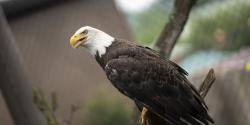Kiwis are the smallest birds in a group called ratites. This group also includes larger, flightless birds like cassowaries, emus, ostriches, and rheas.
Most birds have a part on their breastbone called a "keel," where their flight muscles attach. However, ratites don’t have keels because they don’t fly. Additionally, their bones are heavier than those of flying birds to help support their weight.
Scientific Name: Apteryx mantelli
Conservation Status: Vulnerable
Size: 1.5 to 2 ft. tall
Weight: 4 to 8 lbs., with females generally being larger
Median Life Expectancy: 13.2 years









